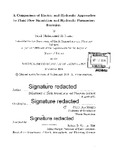| dc.description.abstract | History matching and prediction of future performance of hydrocarbon reservoirs and groundwater aquifers are considered some of the biggest challenges facing hydrologists and petroleum engineers. The complexity of the simulation method, in addition to the huge amount of input data, makes evaluating the reservoir performance expensive. The conventional reservoir history matching procedure usually requires a trial and error process of altering various reservoir parameters and simulating the pressure distribution and field production, or what is known as 'Forward Modeling'. In this study, I propose the use of regular electrical arrays to simulate aquifer drawdowns. By representing reservoir hydraulic conductivities as electric resistors and storativities as capacitors, simulating the potential response gives results similar to that of solving the hydraulic flow equations. Scaling the electrical parameters results in an equivalent approximation of voltage and hydraulic head. A set of synthetic aquifer models with increasing structure complexity were simulated under the Dupuit-Fochheimer assumption of negligible vertical flow. Under the finite difference scheme, aquifers subjected to a constant pumping rate were modeled under different boundary conditions. The transient drawdown data curves from either a single well or multiple wells were obtained, and the reservoir data were inverted for the hydraulic parameters. Because both electrical and hydraulic approaches result in similar response, parameters inversion can be performed on either system. Consequently, the hydraulic equations were used in the inversion. Inversion was performed according to the method of damped least-square where the Jacobian matrix is decomposed by Singular Value Decomposition (SVD). Furthermore, hydraulic aquifers are attempted to be modeled with a binary conductivity structure, which is an effective medium of two hydraulic conductivities. | en_US |

